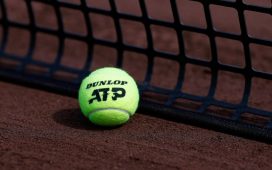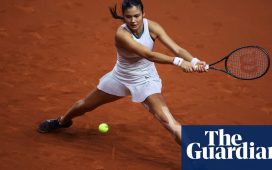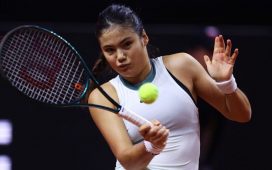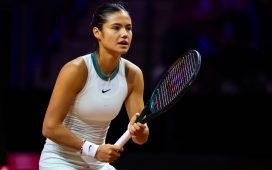For Petra Kvitova, the allure of playing in the WTA Finals isn’t the record-breaking $4.725 million first-prize check — the largest ever in men’s or women’s tennis. It isn’t the prestige of being one of only eight singles competitors to qualify for the year-end championships or the chance to experience the new venue, the Shenzhen Bay Sports Center, in China.
For Kvitova, 29, the best part about playing the WTA Finals is the tranquillity.
“There is great quietness in the dining room and in the locker room,” said Kvitova, the Women’s Tennis Association’s No. 6-ranked player. She is competing in the finals, which she won in 2011, for the seventh time. “Instead of so many of us at a tournament, there are only eight, plus the doubles players, so we each get our own space to be with just our teams. It is actually quite peaceful.”
In pro tennis, there is little peace and even less of an off season. Players, for the most part, compete 10 months of the year in far-flung locations, then take a brief vacation and start training for the next season. Most leave home in December for Australia and play warm-up events before the first major of the year, the Australian Open, begins in mid-January. By the time they reach the WTA Finals in late October, bodies and spirits are depleted.
“Everybody’s tired, and everyone has some injuries by the end,” Kvitova said. A two-time Wimbledon champ, she was runner-up to Naomi Osaka at this year’s Australian Open before being forced off the tour for six weeks in the spring with an arm problem. “There’s never enough time to really recover because we’re always on the road. It’s tough to play your best every match that way.”
Recent history has seen a shift on the WTA Tour, from one player — usually Serena Williams — winning multiple major titles to a more even distribution of champions. The last three years have seen four different winners at each of the majors.
Not since Angelique Kerber captured the Australian and United States Opens in 2016 has there been a repeat winner at Grand Slam tournaments. And in none of those years did the winner of a major also capture the year-end championships.
In 2017, Serena Williams, Jelena Ostapenko, Garbiñe Muguruza and Sloane Stephens all won majors, and Caroline Wozniacki took the WTA Finals. In 2018, Wozniacki, Simona Halep, Kerber and Osaka won the four majors, and Elina Svitolina took her first big title by defeating Stephens at the WTA Finals in Singapore.
This year, Osaka won the Australian, Ashleigh Barty the French, Halep grabbed Wimbledon and Bianca Andreescu beat Serena Williams at the U.S. Open to win her first major.
“You really have to take into account the volatility in women’s tennis right now,” said Tracy Austin, the former world No. 1 who won the year-end finals in 1980, in between her two U.S. Open championships in 1979 and ’81. “Spreading the wealth has become commonplace because no one has really taken hold and dominated since Serena.”
The top-ranked Barty and No. 4 Andreescu will be competing in the WTA Finals for the first time. Other qualifiers include Kvitova; No. 2 Karolina Pliskova, who won titles this year on hard, clay and grass courts; Halep, who defeated Serena Williams 6-2, 6-2 to claim her first Wimbledon title in July; Osaka, who captured back-to-back titles in Osaka, Japan and Beijing this fall; the defending WTA Finals champion, Svitolina, who reached the semis at Wimbledon and the U.S. Open this season; and Belinda Bencic, who took Moscow this week.
Making the finals “was my goal,” Osaka said from Beijing. “After I lost at the U.S. Open, I don’t want to say I planned it, but I sort of meditated on it. Now it feels like I accomplished what I set out to do.
“I was too stats-oriented after I won the Australian Open,” said Osaka, who reached No. 1 after winning back-to-back majors at the 2018 U.S. Open and 2019 Australian Open but fell to No. 4 after losing to Bencic in the round of 16 at the U.S. Open this year. “I was counting the rankings points. And I felt like I shouldn’t lose a match after that. Having that dip humbled me and made me really motivated.”
With just a week and two tournaments left in the regular WTA Tour season, the last qualifying spot for the WTA Finals was up for grabs.
One of those contenders was the five-time champion Serena Williams, who played only eight tournaments this year. Still, she managed to reach the finals at Wimbledon and the U.S. Open before she withdrew from Beijing with a knee injury.
Serena Williams last played the finals in 2014 when she defeated Halep for the title. She lost the final spot this year when Bencic beat Anastasia Pavlyuchekova in Moscow. Bencic, who was ranked No. 7 in the world in early 2016, also won Dubai this year and reached the semifinals at Indian Wells and the U.S. Open.
Kiki Bertens and Sofia Kenin are alternates in Shenzhen. Given that all qualifiers compete in three round-robin matches before the single-elimination semifinals, there have been many years in which a player has dropped out and the alternate has slipped into the mix. That can mean a financial windfall for someone who didn’t actually qualify.
“That’s actually one of the big differences in the year-end finals,” Kvitova said. “Because we’re playing the round robin, you can lose but you’re still in the tournament. You always feel pressure to play your best.”
Austin said the evolution of professional tennis has also left players tired by the end of the year.
“The tour is so much more global now,” she said. “Players are taking long flights all over the world and adapting to time changes and different cultures and food. It’s physically and mentally exhausting, and everybody’s running on fumes by now.
“But they need to stay engaged and not allow the mental fatigue to take over,” Austin added. “The money they’re chasing is just insane. That’s enough motivation.”








